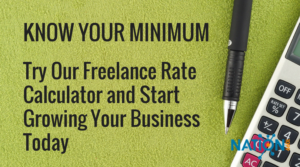Setting your freelance rate is at the core of building a freelance business. It hinges on knowing your market, your customer’s needs, the solution you provide and the value of that solution.
Too many consultants and freelancers are messing around with very low pay. And it is usually totally unnecessary. As our survey of gig economy data shows, 20 percent of all professional freelancers earn more than $100,000/year.
Pricing your freelance work and effectively explaining your value to clients can be very stressful for independent contractors. In reality, the emotional stakes are often not as high as we may feel. It is possible to maximize your your freelance rates and eliminate double-guessing that paralyzes many independents.
Update: Go directly to this article with a formula on setting freelance rates
According to Ted Leonhardt, creative talent coach and founder of the Leonhardt Group, creatives, who make up a vast portion of the modern gig economy, are especially susceptible to the emotional anxieties of quantifying their worth and negotiating a project rate.
“We in fact are emotional beings as creatives and our work is part of our self-definition,” he said in an interview with Ilise Benun on HOW Design Live. “So when we’re in a situation that’s stressful, we’re far more vulnerable than the general population is to succumb to those feelings and as a result, roll over, give in or just do not ask for what we would like.”
(By the way, Ilise has a lot of experience coaching freelancers like us on pricing, marketing and finding the ideal client. You should definitely check out her resources.)
Our guest author David Maurice Sharp makes a similar point about creatives in his article, Freelance Finances: Manage Your Income Like A Thriving Artist. “Drawing on the creative and professional skills you already have and applying them to your pursuit of financial well-being can make the journey easier,” he says.
Indeed, discussion of freelance rates can send even veteran writers, designers and developers into a panic. The endorphin rush of engaging a potential client can quickly give way to fears of being undervalued and perceived as an imposter.
In this piece we will tell that nagging voice of self-doubt to put a lid on it and organize an effective plan for getting the freelance rate you deserve.
Understand and demonstrate your value
When I think of myself in the vastly oversimplified terms of a LinkedIn job title (i.e. freelance content writer), I get no sense of my own value. And value is key in gathering the confidence necessary to getting a freelance rate you deserve.
As an exercise, I often recommend that my fellow freelancers and solopreneurs create a value list or a bullet summary of what they believe they are worth — well beyond the buzzy title.
Though I am a freelance content writer, there is so much more I do for my clients and far more, still, I can offer them toward the pursuit of their success:
Value list:
• I create a specialized voice for their brands tailored toward engaging their clientele.
• I perform extensive keyword research to help them rank for the terms they need a search engine presence for.
• I perform rigorous research on the topics that matter to these clients and make myself an expert on them.
• I plan client content.
• I edit and format my own work for optimal viewing and SEO purposes.
• I make myself an accessible consultant to my clients.
• I bring over 10 years of online writing expertise to my projects.
PHEW . . . that was a lot. Far more than you might expect for a so-called “freelance content writer.” It’s a bit more than I realized I actually do.
Don’t just rush into a client negotiation and assume your value is implied or expressly clear. I can guarantee that this is very often not the case.
Knowing exactly what you offer and having a very clear understanding of the time it takes you to use these superpowers should inform the quotes you give clients. It will irk you every day if your freelance rate doesn’t reflect your time and effort.
First and foremost — your client wants the job done
Fortune 500 companies, small businesses and even other independent contractors outsource countless projects every day because they need them done, and they don’t want to worry about them.
That’s the bottom line. Your prospective clients are less concerned about your freelance rate than about the problem they need solved.
Don’t be afraid to ask for the number you truly want; more often than you’d expect, you’ll be in the clear.
Do you know why there are so many websites emerging that match consultants with companies?
It’s because companies dread having to search for contingent workers. If you properly demonstrate your worth and are have a good rationale for your freelance rate, being a little on the higher end of the spectrum is unlikely to send your prospective client running from very well qualified freelance talent.
Sometimes higher freelance rates can make you stand out in a good way — believe it or not. How many times have you purchased the more expensive item on the shelf because the price reassured you of its high quality?
How many times have you purchased the more expensive item on the shelf because the price reassured you of the high quality?
Coming to a client with a freelance rate that is too low can make you look green and convey that you do not value your own work.
Have an hourly rate, but consider charging by the project
Hourly rates for freelance work can be very helpful when ball-parking what to charge your clients, and they can be very lucrative in certain cases.
But in others, the results are less than ideal. Freelance web designer and consultant Jake Jorgovan tells of an amusing and unfortunate scenario early in his freelance career in a recent blog. Jorgovan defaulted to the hourly payment method with a rate that was quite reasonable.
Unfortunately, despite doing a top-notch job on his client’s website, the project was completed far ahead of time in just three hours. This left his client with a stellar website. But it left the freelancer professional with a small payment relative to the value of the product he delivered.
This example elegantly illustrates the need for alternative pricing models — specifically, “by-project” pricing.
Project-based pricing gives you the freedom to charge for the skill and experience you bring to projects, while also building in room for unexpected time variables.
In other words, don’t assume that your freelance rate describes an hourly rate. Sometimes you are describing your rate for a project.
(And the alternative ways of structuring your fees as a freelancer doesn’t stop with project-based pricing. Retainer pricing can be a powerful way of building recurring income.)
Related reading: The Beginner’s Guide To Getting Upfront Payment From Freelance Clients
Many clients actually prefer the “all in” mode of a project-based pricing. It reduces the uncertainty of quotes based on an approximation of hours. For example, consider a $600 estimate vs. 10-20 billable hours at $40 an hour. Which one looks less intimidating?
It goes without saying that there is no uniform way to convert your freelance rate to a project-based price. You will typically find high, low and average hourly figures by industry, whether web design, copywriting, graphic design or beyond.
Update: But our new freelance rate calculator should help you start that conversion.
Regardless of your professional skills, always consider the scale of your client’s business. You may find yourself working for a large corporate entity, where charging toward the higher end of industry standards is the expectation and a great opportunity to experiment with higher freelance rates.
However, you may also acquire some projects in a developmental phase and that are tighter in terms of funding. But this does not mean you should propose a rate below your skill level. Work with the client to determine which of your services are simply less essential to keep them within budget.
You’re a professional, so don’t adjust your price. Adjust the scope of work.
You have your freelance rate — now be firm
Pricing yourself is stressful because it invites the possibility of rejection, as Leonhardt also notes in his podcast. This can be difficult to grapple with, as many of us on the creative end directly associate our work with our personal value.
Don’t let this fear hold you and your ambitions hostage. Whatever the end result, you will grow from these experiences and find the negotiation process easier and more intuitive with each project you explore.
Determine your value and stand by it. You will impress yourself.
Additional reading to help you set freelance rates
5 Biggest Things You’re Forgetting in Your Freelance Rates
7 Powerful Strategies for Getting Recurring Income as a Freelancer
The Path To Higher Paying Clients – Insights From the Marketing Mentor
The Beginner’s Guide To Getting Upfront Payment From Freelance Clients

Ben Shanbrom is a freelance writer, musician and copy editor who works with artists and other clients around his native New Haven and well beyond.











